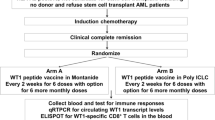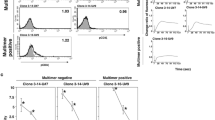Abstract
Introduction
The peptide-based cancer vaccine targeting Wilms’ tumor 1 (WT1) is a promising immunotherapeutic strategy for hematological malignancies. It remains unclear how long and to what extent the WT1-specific CD8 + cytotoxic T cell (CTL) persist after WT1 peptide vaccination.
Methods
The WT1 peptide vaccine was administered with written consent to a patient with CML in the chronic phase who did not respond well to imatinib, and the patient was followed for 12 years after vaccination. Immune monitoring was performed by specific amplification of WT1-specific CTLs using a mixed lymphocyte peptide culture. T-cell receptors (TCRs) of amplified WT1-specific CTLs were analyzed using next-generation sequencing. This study was approved by the Institutional Review Board of our institution.
Result
WT1-specific CTLs, which were initially detected during WT1 peptide vaccination, persisted at a frequency of less than 5 cells per 1,000,000 CD8 + T cells for more than 10 years. TCR repertoire analysis confirmed the diversity of WT1-specific CTLs 11 years after vaccination. CTLs exhibited WT1 peptide-specific cytotoxicity in vitro.
Conclusion
The WT1 peptide vaccine induced an immune response that persists for more than 10 years, even after cessation of vaccination in the CML patient.



Similar content being viewed by others
Data availability
The data that support the findings of this study are available from the corresponding author, M.M., upon reasonable request.
References
Yang Y. Cancer immunotherapy: harnessing the immune system to battle cancer. J Clin Invest. 2015;125(9):3335–7.
Butterfield LH. Cancer vaccines. BMJ. 2015;350: h988.
Wei X, Chen F, Xin K, Wang Q, Yu L, Liu B, et al. Cancer-testis antigen peptide vaccine for cancer immunotherapy: progress and prospects. Transl Oncol. 2019;12(5):733–8.
Di Stasi A, Jimenez AM, Minagawa K, Al-Obaidi M, Rezvani K. Review of the results of WT1 peptide vaccination strategies for myelodysplastic syndromes and acute myeloid leukemia from nine different studies. Front Immunol. 2015;6:36.
Ahlers JD, Belyakov IM. Memories that last forever: strategies for optimizing vaccine T-cell memory. Blood. 2010;115(9):1678–89.
Klebanoff CA, Gattinoni L, Restifo NP. CD8+ T-cell memory in tumor immunology and immunotherapy. Immunol Rev. 2006;211:214–24.
Oka Y, Tsuboi A, Kawakami M, Elisseeva OA, Nakajima H, Udaka K, et al. Development of WT1 peptide cancer vaccine against hematopoietic malignancies and solid cancers. Curr Med Chem. 2006;13(20):2345–52.
Oji Y, Inoue M, Takeda Y, Hosen N, Shintani Y, Kawakami M, et al. WT1 peptide-based immunotherapy for advanced thymic epithelial malignancies. Int J Cancer. 2018;142(11):2375–82.
Keilholz U, Letsch A, Busse A, Asemissen AM, Bauer S, Blau IW, et al. A clinical and immunologic phase 2 trial of Wilms tumor gene product 1 (WT1) peptide vaccination in patients with AML and MDS. Blood. 2009;113(26):6541–8.
Oka Y, Tsuboi A, Taguchi T, Osaki T, Kyo T, Nakajima H, et al. Induction of WT1 (Wilms’ tumor gene)-specific cytotoxic T lymphocytes by WT1 peptide vaccine and the resultant cancer regression. Proc Natl Acad Sci U S A. 2004;101(38):13885–90.
Rezvani K, Yong AS, Mielke S, Savani BN, Musse L, Superata J, et al. Leukemia-associated antigen-specific T-cell responses following combined PR1 and WT1 peptide vaccination in patients with myeloid malignancies. Blood. 2008;111(1):236–42.
Tsuboi A, Hashimoto N, Fujiki F, Morimoto S, Kagawa N, Nakajima H, et al. A phase I clinical study of a cocktail vaccine of Wilms’ tumor 1 (WT1) HLA class I and II peptides for recurrent malignant glioma. Cancer Immunol Immunother. 2019;68(2):331–40.
Ueda Y, Ogura M, Miyakoshi S, Suzuki T, Heike Y, Tagashira S, et al. Phase 1/2 study of the WT1 peptide cancer vaccine WT4869 in patients with myelodysplastic syndrome. Cancer Sci. 2017;108(12):2445–53.
Anguille S, Van de Velde AL, Smits EL, Van Tendeloo VF, Juliusson G, Cools N, et al. Dendritic cell vaccination as postremission treatment to prevent or delay relapse in acute myeloid leukemia. Blood. 2017;130(15):1713–21.
Kan S, Bito T, Shimabuku M, Taguchi J, Ohkusa T, Shimodaira S, et al. Impact of mature dendritic cells pulsed with a novel WT1 helper peptide on the induction of HLAA2restricted WT1reactive CD8+ T cells. Int J Oncol. 2020;57(4):1047–56.
Fujiki F, Oka Y, Tsuboi A, Kawakami M, Kawakatsu M, Nakajima H, et al. Identification and characterization of a WT1 (Wilms Tumor Gene) protein-derived HLA-DRB1*0405-restricted 16-mer helper peptide that promotes the induction and activation of WT1-specific cytotoxic T lymphocytes. J Immunother. 2007;30(3):282–93.
Narita M, Masuko M, Kurasaki T, Kitajima T, Takenouchi S, Saitoh A, et al. WT1 peptide vaccination in combination with imatinib therapy for a patient with CML in the chronic phase. Int J Med Sci. 2010;7(2):72–81.
Demotte N, Stroobant V, Courtoy PJ, Van Der Smissen P, Colau D, Luescher IF, et al. Restoring the association of the T cell receptor with CD8 reverses anergy in human tumor-infiltrating lymphocytes. Immunity. 2008;28(3):414–24.
Saitoh A, Narita M, Watanabe N, Tochiki N, Yamahira A, Nakamura T, et al. WT1 peptide vaccination in a CML patient: induction of effective cytotoxic T lymphocytes and significance of peptide administration interval. Med Oncol. 2011;28(1):219–30.
Nakamae H, Yoshida C, Miyata Y, Hidaka M, Uike N, Koga D, et al. A new diagnostic kit, ODK-1201, for the quantitation of low major BCR-ABL mRNA level in chronic myeloid leukemia: correlation of quantitation with major BCR-ABL mRNA kits. Int J Hematol. 2015;102(3):304–11.
Hughes T, Deininger M, Hochhaus A, Branford S, Radich J, Kaeda J, et al. Monitoring CML patients responding to treatment with tyrosine kinase inhibitors: review and recommendations for harmonizing current methodology for detecting BCR-ABL transcripts and kinase domain mutations and for expressing results. Blood. 2006;108(1):28–37.
Iwabuchi M, Narita M, Uchiyama T, Iwaya S, Oiwa E, Nishizawa Y, et al. Enhancement of the antigen-specific cytotoxic T lymphocyte-inducing ability in the PMDC11 leukemic plasmacytoid dendritic cell line via lentiviral vector-mediated transduction of the caTLR4 gene. Mol Med Rep. 2015;12(2):2443–50.
Tanaka-Harada Y, Kawakami M, Oka Y, Tsuboi A, Katagiri T, Elisseeva OA, et al. Biased usage of BV gene families of T-cell receptors of WT1 (Wilms’ tumor gene)-specific CD8+ T cells in patients with myeloid malignancies. Cancer Sci. 2010;101(3):594–600.
Nakata J, Nakajima H, Hayashibara H, Imafuku K, Morimoto S, Fujiki F, et al. Extremely strong infiltration of WT1-specific CTLs into mouse tumor by the combination vaccine with WT1-specific CTL and helper peptides. Oncotarget. 2018;9(89):36029–38.
Golubovskaya V, Wu L. Different subsets of T cells, memory, effector functions, and CAR-T immunotherapy. Cancers (Basel). 2016;8(3):36.
Canale FP, Ramello MC, Nunez N, Araujo Furlan CL, Bossio SN, Gorosito Serran M, et al. CD39 expression defines cell exhaustion in tumor-infiltrating CD8(+) T cells. Cancer Res. 2018;78(1):115–28.
Simoni Y, Becht E, Fehlings M, Loh CY, Koo SL, Teng KWW, et al. Bystander CD8+ T cells are abundant and phenotypically distinct in human tumour infiltrates. Nature. 2018;557(7706):575–9.
Duhen T, Duhen R, Montler R, Moses J, Moudgil T, de Miranda NF, et al. Co-expression of CD39 and CD103 identifies tumor-reactive CD8 T cells in human solid tumors. Nat Commun. 2018;9(1):2724.
Zeng R, Spolski R, Finkelstein SE, Oh S, Kovanen PE, Hinrichs CS, et al. Synergy of IL-21 and IL-15 in regulating CD8+ T cell expansion and function. J Exp Med. 2005;201(1):139–48.
Kitaura K, Yamashita H, Ayabe H, Shini T, Matsutani T, Suzuki R. Different somatic hypermutation levels among antibody subclasses disclosed by a new next-generation sequencing-based antibody repertoire analysis. Front Immunol. 2017;8:389.
Sewell AK. Why must T cells be cross-reactive? Nat Rev Immunol. 2012;12(9):669–77.
Morimoto S, Fujiki F, Kondo K, Nakajima H, Kobayashi Y, Inatome M, et al. Establishment of a novel platform cell line for efficient and precise evaluation of T cell receptor functional avidity. Oncotarget. 2018;9(75):34132–41.
Watanabe K, Toji S, Ohtake J, Nakano K, Satoh T, Kitamura H, et al. Establishment of a stable T lymphoma cell line transduced with HLA-A*24:02-restricted WT1-specific TCR genes and its application to antigen-specific immunomonitoring. Biomed Res. 2013;34(1):41–50.
Kondo K, Fujiki F, Nakajima H, Yatsukawa E, Morimoto S, Tatsumi N, et al. An essential role of the avidity of T-cell receptor in differentiation of self-antigen-reactive CD8+ T cells. J Immunother. 2016;39(3):127–39.
Fujiki F, Tsuboi A, Morimoto S, Hashimoto N, Inatome M, Nakajima H, et al. Identification of two distinct populations of WT1-specific cytotoxic T lymphocytes in co-vaccination of WT1 killer and helper peptides. Cancer Immunol Immunother. 2021;70(1):253–63.
Sallusto F, Geginat J, Lanzavecchia A. Central memory and effector memory T cell subsets: function, generation, and maintenance. Annu Rev Immunol. 2004;22:745–63.
Yost KE, Satpathy AT, Wells DK, Qi Y, Wang C, Kageyama R, et al. Clonal replacement of tumor-specific T cells following PD-1 blockade. Nat Med. 2019;25(8):1251–9.
Arpinati M, Tolomelli G, Bochicchio MT, Castagnetti F, Amabile M, Bandini G, et al. Molecular monitoring of BCR-ABL transcripts after allogeneic stem cell transplantation for chronic myeloid leukemia. Biol Blood Marrow Transplant. 2013;19(5):735–40.
Clapp GD, Lepoutre T, Nicolini FE, Levy D. BCR-ABL transcript variations in chronic phase chronic myelogenous leukemia patients on imatinib first-line: possible role of the autologous immune system. Oncoimmunology. 2016;5(5): e1122159.
Acknowledgements
The present study was supported in part by JSPS KAKENHI Grant Number JP17K09006 to Y.S., JP18K07410 to M.N., and JP16K09868 to M.M. and a Japanese Society of Hematology Research Grant (2019–2020) to M.M.
Author information
Authors and Affiliations
Contributions
TS, MN, and MM designed the present study, conducted all experiments, analyzed the data obtained, and wrote the manuscript. TS and MN performed the MLPC assay. HS supervised this work. All authors discussed the results and contributed to the final manuscript.
Corresponding author
Ethics declarations
Conflict of interest
The authors report no conflicts of interest.
Additional information
Publisher's Note
Springer Nature remains neutral with regard to jurisdictional claims in published maps and institutional affiliations.
About this article
Cite this article
Suwabe, T., Shibasaki, Y., Tamura, S. et al. Decade-long WT1-specific CTLs induced by WT1 peptide vaccination. Int J Hematol 119, 399–406 (2024). https://doi.org/10.1007/s12185-024-03723-1
Received:
Revised:
Accepted:
Published:
Issue Date:
DOI: https://doi.org/10.1007/s12185-024-03723-1




